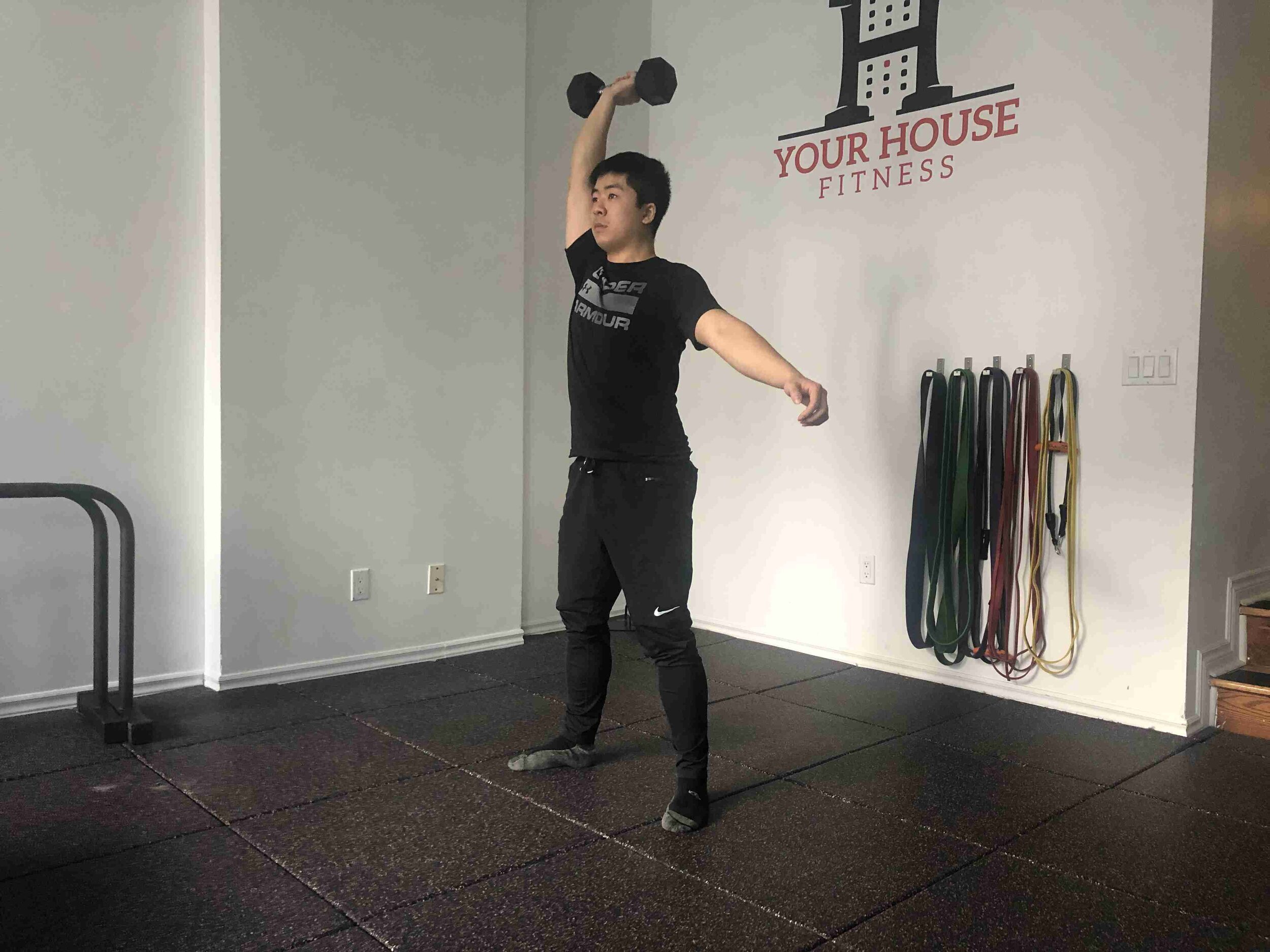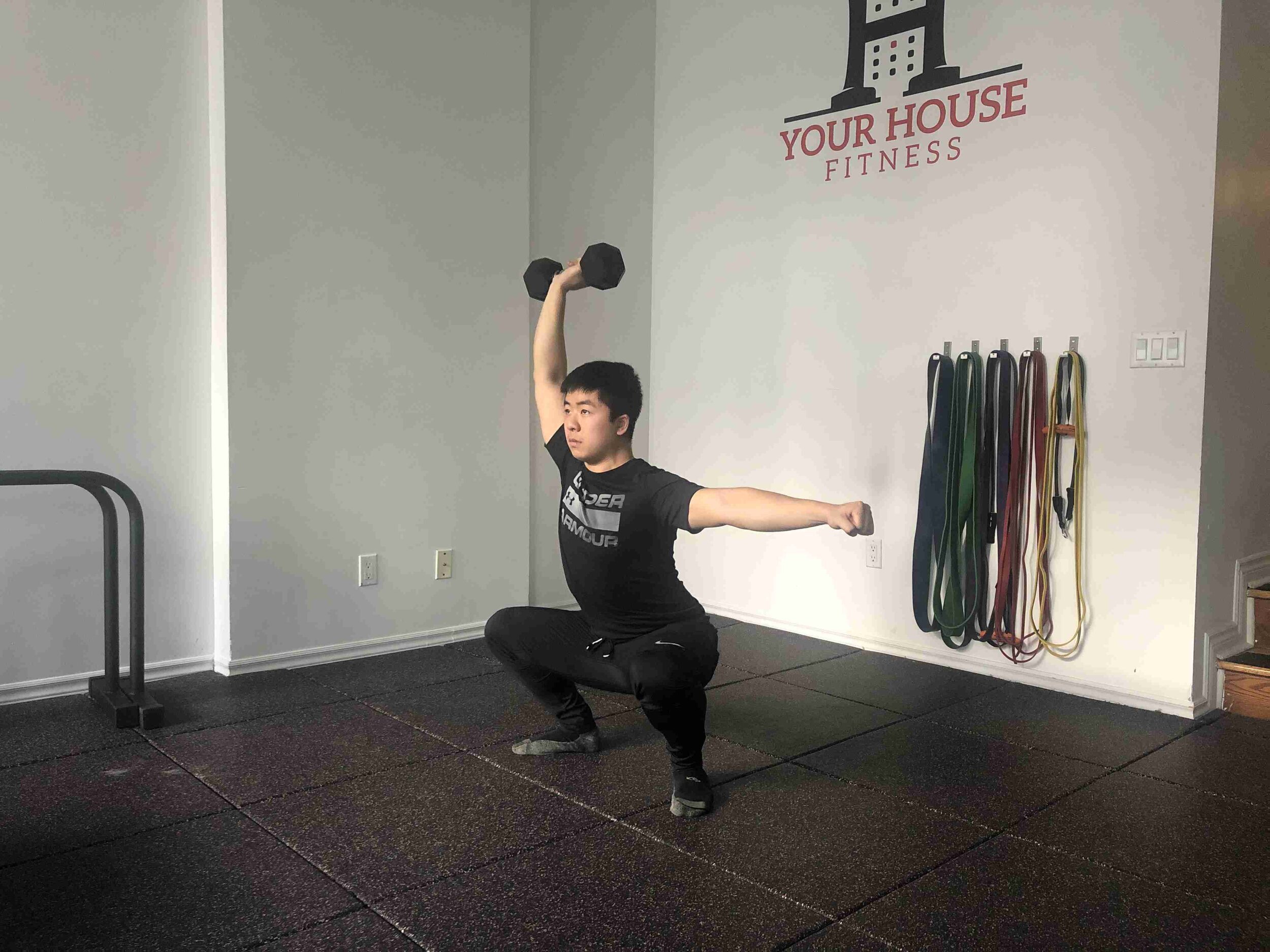Exercise Tutorial: Dumbbell Squat
Revised by Stephanie Zaban (Registered Kinesiologist & Masters of Kinesiology)Table of Contents
What Is a Dumbbell Squat
The dumbbell squat is a low-impact exercise that involves a pair of weighted dumbbells and targets the lower body muscles.
How to Dumbbell Squat
To get started, stand with your feet at least shoulder-width apart, making sure that your gravity and balance is centered. Ensure that your feet are planted securely on the floor.
Grab a pair of dumbbells and hold them at your sides. Have your feet face straight while making sure your toes are pointed to the front. Doing this decreases the pressure that can build up in your knees.
Lock your back at a straight angle, then tighten your abdominal muscles. When doing this exercise, your quad muscles, gluteus maximus, medius and minimus, and abdomen should do all of the work and your back should stay rigid and in place.
Next, slowly bend your knees and lower to a squat position. Slowly descend and when you reach a 90-degree angle, stop and, come to a full stand.
Dumbbell Squat Form
Maintaining your form in the Dumbbell Squat is crucial to avoid injury and training improper movement patterns. Some quick tips for maintaining Dumbbell Squat Form include:
Keeping a neutral spine. Avoid any rounding of the back.
Keep your shoulders down and back. This also helps to prevent rounding.
Keep your knees in line with your toes.
Keep your heels down, and toes down.
Maintain a forward gaze.
Read about how to fix the forward lean in your squat.
Is Performing a Dumbbell Squat Safe
When performing squats with proper technique, dumbbell squats can be very safe. In fact, adding them to your squat can provide a great, fun, and new alternative to progress your bodyweight squats. Providing you with a new stimulus to build muscle, create challenges and inevitably progress in your fitness journey.
Dumbbell Squat Benefits
There are many benefits that you can achieve when you incorporate the Dumbbell Squat into your exercise regime. These benefits include:
Increased stability.
Increased muscular strength.
Many variations to target different muscles.
Requires minimal space.
Great for beginners.
When and Why Should You Use Dumbbells for Squats
Mastering the bodyweight squat is always the first goal in your squatting journey. Once you have perfected the squat and can perform a few sets with a good amount of reps, it’s definitely time for you to spice it up. Start off light, grab 5’s or 10’s, put them in a front rack position and let the fun begin. Soon enough you will see your squat gains pick up quickly.
Dumbbell Squat Progression
To progress with the dumbbell squat, you should be able to easily grab two 20lb dumbbells at your shoulders and comfortably squat for a few sets of 10 reps. Then... it will be time to hit another milestone. Getting that 45lb barbell on your back may seem intimidating at first, but, keep in mind that if you don’t progress you will continue to see the same results. Another great option aside from the barbell back squat is split squats or walking lunges which will target the legs with a great amount of volume.
Keep in mind, without a second eye watching your form, dumbbell squats may pose a risk and this can be due to muscular fatigue, in turn adding difficulty in recovering your balance.
Advanced Cues for the Dumbbell Squat
You can increase the effectiveness of the squat by contracting your abs while doing it. Simply squeeze your butt when you stand up.
Lock your back in one angle, and keep it there throughout the movement. During squats, you want the impact to be on your glutes, not on your spine.
Keep your head up. According to research, looking down while squatting puts unnecessary strain on your back and neck.
When starting out, it may be best not to have any weights. Work on your form and when you’re confident...begin to add load.
Never arch backward - this is the most common mistake people make when performing dumbbell squats. This may place a lot of strain on your spine.
-Distribute your load evenly - after finding a comfortable and safe posture, ensure that your load is evenly distributed and your core is braced at all times.
Maintain good posture throughout. This will ensure your back won’t be placed at risk of injury, and this is also a great way to make sure that your quadriceps, hip flexors, and glutes are doing most of the work.
Dumbbell Squat Variations
Here is a list of several variations of the dumbbell squat: Dumbbell Front Squat, Dumbbell Sumo Squat, Dumbbell Overhead Squat, Zercher Squat, and the Dumbbell Single Arm Overhead Squat.
Side to Side Dumbbell Squat
Dumbbell Overhead Squat
To perform the Dumbbell Overhead Squat, begin in the conventional Dumbbell Squat position. For the Dumbbell Overhead Squat, we are going to raise the dumbbells over the head by extending our arms. Proceed to squat as usual. Remember to keep the dumbbell in line with the ears as you perform this movement and keep the spine in a neutral position. You do not want the dumbbells to be in front of the head. The Dumbbell Overhead Squat is a great exercise to challenge your upper-body mobility.
Dumbbell Sumo Squat
To perform the Dumbbell Sumo Squat, begin in a wide stance. This means that your feet are spread farther than shoulder-width apart, and your toes are pointing outwards. For the Dumbbell Sumo Squat, you will only need one dumbbell which you will hold with one hand. Your grip should have both hands holding onto the edge of one end of the dumbbell or, you can hold onto the shaft of the dumbbell. Regardless of your grip, position the dumbbell around the pelvic area to start. Keeping your back straight, and engaging the glutes, begin to squat down. Return to the starting position and repeat the movement.
Dumbbell Single Arm Overhead Squat
The Dumbbell Single Arm Overhead Squat is almost the same as the Dumbbell Overhead Squat. Begin with your feet shoulder-width apart. Elevate one arm with a dumbbell straight above the shoulder with your armpit facing forwards. Next, perform the squat movement while maintaining a straight spine and keeping your knees in line with the toes. You can extend your available arm out to your side as you squat to provide additional balance.
Dumbbell Front Squat
To perform the Dumbbell Front Squat, hold onto a dumbbell in each hand. Stand with your feet shoulder-width apart and bend at the elbow so that your dumbbells are at shoulder height/just above the shoulders. Keeping your back straight and abdomen braced, squat down so that your femur is parallel to the floor. Return to the starting position and repeat the movement.
Dumbbell Squat Vs Barbell Squat
Both the Dumbbell Squat and the Barbell Squat are amazing exercises for the lower body. The Dumbbell Squat has many variations such as the Front Squat, Overhead Squat and Sumo Squat. Likewise, the Barbell Squat has many variations such as the Back Squat, Front Squat, Overhead Squat and Zercher Squat.
So what is the difference between the two? Well, the Barbell Squat will allow you to use greater loads, which contributes to building muscle faster. As well, Barbell Squats allow for more explosive power to be developed. However, the Dumbbell Squat requires more stability and can offer a more natural range of motion as opposed to a barbell. Dumbbell Squats are a great option for beginners, but you are limited in the amount of weight you can use. Overall, both the Dumbbell Squat and Barbell Squat are great exercises for building strength!
Dumbbell Squat Muscles Worked
The Dumbbell Squat involves the following muscles:
Gluteus Maximus, Medius and Minimus
Depending on the variation of the Dumbbell Squat, you can activate additional muscles!
Dumbbell Squat Workout
Spice up your workout and gradually begin to add intensity with some of these variations. Select an exercise from the list below and perform the recommended sets and reps. (OR Compound Set 2 or more exercises back to back for the prescribed set and rep ranges).
Beginner: 3 Sets of 12-15 reps
Intermediate: 4-6 Sets of 15-20 reps
Advanced: 6-8 Sets of 40-60 reps
Here is the Japanese version of this article: How to Dumbbell Squat
Here is the Spanish version of this article: How to Dumbbell Squat











